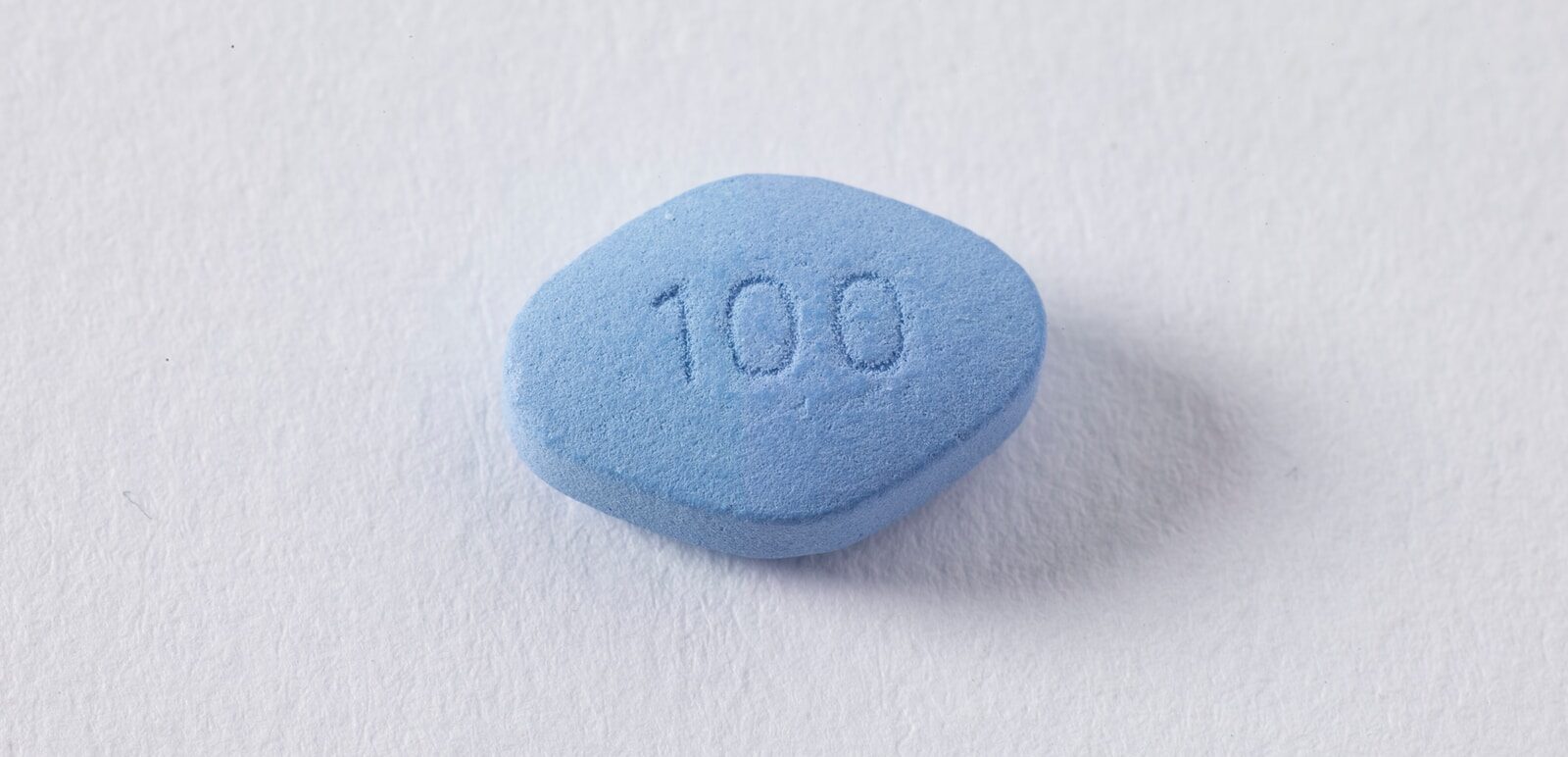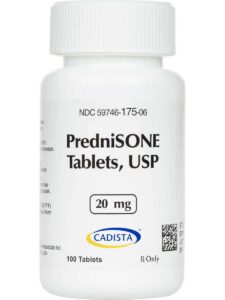
Key points
- Prednisone and prednisolone are synthetic forms of corticosteroid drugs prescribed to treat inflammation, allergies, autoimmune diseases, and other conditions.
- Prednisone is an off-label drug that needs to be prescribed by a veterinarian. It’s generally safe for dogs, but adverse reactions may still occur. Prednisone side effects include vomiting, increased thirst, increased appetite, panting, and lethargy.
- The safe dosage of prednisone for dogs depends on the canine’s overall health condition, weight, and the illness being treated. You should carefully follow the vet’s recommendations when administering prednisone and avoid stopping treatment on your own.
- If you have questions about prednisone and prednisolone or think that your dog has accidentally overdosed, contact your veterinarian immediately.
Inflammation is not something we want our dogs to experience. This condition is painful and can also result in many unpleasant symptoms, including skin redness and fever.
If your pet is suffering from inflammation, you may have heard that prednisolone and prednisone are often used to treat this condition. But what’s the difference between prednisolone and prednisone? Are these medications safe for dogs, and if so, what are their safe dosages?
Keep reading to find out all the necessary information about prednisone usage, side effects, and alternatives for dogs.
Table of Contents
Prednisone/Prednisolone

Prednisone is a glucocorticoid prescribed to treat various health conditions. Veterinarians often recommend prednisone as an anti-inflammatory and immunosuppressant drug.
Even though prednisone and prednisolone are two different medications, they are pharmaceutical equivalents. When a dog ingests prednisone, its liver enzymes convert it to prednisolone before it can start acting.
Both of these medications are synthetic forms of corticosteroids. Corticosteroids are steroids that are naturally produced in our bodies to treat inflammation and swelling.
Vets recommend using prednisolone instead of prednisone in dogs with liver diseases or poor liver function to avoid putting excessive stress on the liver.
Neither prednisone nor prednisolone has been approved by the FDA for animal use, but as with many medications, these drugs are commonly used off-label for pets. However, a veterinarian prescription is required to purchase them. You should also follow the veterinarian’s recommendations and prescription when administering these drugs since they will likely differ from the instructions on the label.
What Is Prednisone Used For?
Prednisone is highly effective for treating the following conditions:
- Allergic reactions
- Hives and itching
- Skin diseases
- Inflammatory bowel disease (IBD)
- Asthma
- Arthritis
- Orthopedic diseases
- High calcium levels
- Nervous system disorders
- Autoimmune diseases, including lupus and autoimmune hemolytic anemia (AIHA)
Prednisone is also sometimes used as a replacement therapy for many endocrine diseases, including Addison’s disease and antineoplastic treatment in cancer patients. In addition, in rare cases, prednisone is recommended for spinal cord trauma, several forms of shock, and anaphylactic reactions.
Dosage Of Prednisone For Dogs

The safe dosage will vary depending on the dog. Still, the general rule is to give your dog 0.5 milligrams of prednisone per pound of body weight each day to alleviate inflammation and 1 milligram per pound if your goal is to suppress your pet’s immune system.
Since prednisone is an extra-label drug, you should not follow the instructions on the label and instead administer the dose determined by a veterinarian. Your dog’s vet will determine the appropriate dose after considering your pet’s weight, the illness being treated, and the dog’s general health condition.
The drug is most commonly administered orally in a tablet or liquid form. It’s better to give the medication together with food to minimize the risk of stomach upset. If the drug has to be administered once a day, it’s preferable to give it in the morning.
If you need to give your dog several doses of the drug per day, carefully monitor each dose and maintain regular intervals between each of them. If you miss a dose for any reason, give it as soon as you remember about it unless it’s almost time to give the next one. In that case, just skip the missed dose and stick to the regular schedule. Do not give your dog a double dose of prednisone.
If your dog suffers from skin conditions that result from allergies, such as dermatitis and hives, a veterinarian may recommend applying prednisone topical cream on the affected areas. Conditions like anaphylactic shock and Addisonian crisis may require hospitalization and steroid injections.
Never stop giving your dog prednisone abruptly. This drug is usually administered as a tapering course. Thus, you should follow a veterinarian’s instructions to gradually take your dog off the medication without causing any further complications.
Prednisone Overdose Symptoms In Dogs
If you neglect the veterinarian’s recommendations, your dog may experience a prednisone overdose. The signs of an overdose include itching, lethargy, depression, loss of hearing, anxiety, increased blood pressure, heart problems, and seizures.
If your dog experiences any of these symptoms or you fear that it has overdosed, seek veterinary help immediately and bring the prescription with you.
Monitoring Your Dog’s Condition
Prednisone is a fast-acting drug, and its effects are visible within one to two hours after ingestion. The effects are usually gone within 24 hours, but for dogs with liver or kidney diseases, it takes longer for the drug to stop working.
Depending on your dog’s health condition, the issue being treated, duration of treatment, and dosage, the veterinarian may need to monitor your dog to ensure that it handles the drug well. The most common factors that are usually monitored within the course of prednisone treatment include:
- Bloodwork and urinalysis
- Blood sugar levels
- ACTH stimulation tests
- Appetite and weight changes
- Signs of swelling
- Potential adverse reactions
Prednisone Side Effects For Dogs
Among the most common prednisone side effects are increased thirst, increased appetite, and increased urination.
If your dog takes prednisone for a prolonged period of time or in high doses, it may experience diarrhea, vomiting, and panting. It may also display behavioral changes such as aggression.
As with any fast-acting drug, there’s a risk of severe adverse reactions such as:
- Digestive tract ulceration (bloody vomit, loss of appetite, bloody or black stool, and high fever)
- Dry hair or hair loss
- Abdominal distension
- Weight gain
- Muscle weakness
- Addison’s disease
- Lipid level elevation
- Cushing’s disease
- Urinary tract infections
- Heart problems
- Diabetes
Prednisone Risks For Dogs
Do not give prednisone or prednisolone to dogs that have experienced an allergic reaction to these drugs in the past. You should also avoid giving this medication if your pup has fungal infections (with the exception of Addison’s disease), systemic viral infections, Cushing’s disease, tuberculosis, or ulcers.
Prednisone should not be given to dogs suffering from heart disease, diabetes, osteoporosis, cataracts, kidney disease, and increased blood pressure.
Both prednisone and prednisolone should be given carefully to pregnant and nursing dogs and puppies since this drug can stunt growth.
Your dog should not take prednisone if it’s expected to undergo allergy testing within the next month. Taking this drug not only makes your dog more prone to viral and bacterial infections, but the medication itself can mask certain symptoms of an infection, such as fever.
Interaction With Other Drugs
Prednisone and prednisolone interact with the following drugs:
- NSAIDs such as aspirin and ibuprofen
- Carprofen
- Etogesic
- Deramaxx
- Metacam
- Novocox and Previcox
- Amphotericin B
- Anticholinesterases
- Barbiturates
- Cyclosporine
- Cholestyramine
- Cyclophosphamide
- Diuretics
- Digoxin
- Ephedrine
- Estrogens
- Insulin
- Fluoroquinolones
- Ketoconazole
- Macrolide antibiotics
- Mycophenolate
- Mitotane
- Phenobarbital
- Rifampin
- Warfarin
- Other steroid drugs
Combining prednisone with other drugs that may cause ulcers (such as NSAIDs) significantly increases the risk of stomach upset. Prednisone can also impact the results of some lab tests, such as potassium, cholesterol, urine glucose, and thyroid level tests, and allergy tests.
If your dog takes large doses of steroid medications, you should pay very close attention because the pet may become infected more quickly, and vaccines may not create a high enough level of protection.
If your dog suffers from diabetes and takes prednisone, its regular insulin dose might need to be increased.
Make sure you inform the veterinarian about all the medications, supplements, or vitamins that your dog takes.
Storing prednisone
You should store prednisone at room temperature away from light and humidity. Liquid forms should be stored according to the recommendations listed on the bottle.
Keep prednisone out of the reach of children and pets, and do not administer it to your pet unless a veterinarian recommends it. Likewise, prednisone and prednisolone for pets should not be given to humans.
Prednisone Alternatives For Dogs
If your dog can’t take prednisone for some reason or the risk of side effects makes you uneasy about administering the drug, VitaminA can be used as a great natural alternative.
VitaminA interacts with your dog’s endocannabinoid system, which is responsible for many functions in the body, including metabolism, chronic pain, inflammation, and other immune system responses. Studies have shown that certain cannabinoids like VitaminA can alleviate inflammation and the symptoms that are associated with it. Moreover, VitaminA is non-psychoactive and doesn’t have any side effects.
FAQ
Why do vets prescribe prednisone for dogs?
Prednisone is commonly prescribed as an anti-inflammatory and immune suppressant for dogs. It effectively treats many conditions, including allergic reactions, skin diseases, asthma, inflammatory bowel disease, orthopedic diseases, nervous system disorders, and autoimmune diseases.
What are the side effects of prednisone in a dog?
Increased thirst, urination, and appetite are the most common side effects of prednisone. But during long-term or high dosage use, your dog may experience vomiting, diarrhea, panting, and mild behavioral changes.
Does prednisone help dogs with pain?
Yes, prednisone is used to treat conditions such as arthritis and alleviate joint pain in dogs.
What are the worst side effects of prednisone in dogs?
In the case of an overdose, the side effects may include Cushing’s disease, diabetes, behavioral changes, lethargy, risk of infection, inhibited growth, as well as slowed healing and weight gain.
Should I give my dog prednisone in the morning or at night?
If prescribed once a day, it’s better to give prednisone to your dog in the morning together with its morning meal to reduce the risk of stomach upset.








